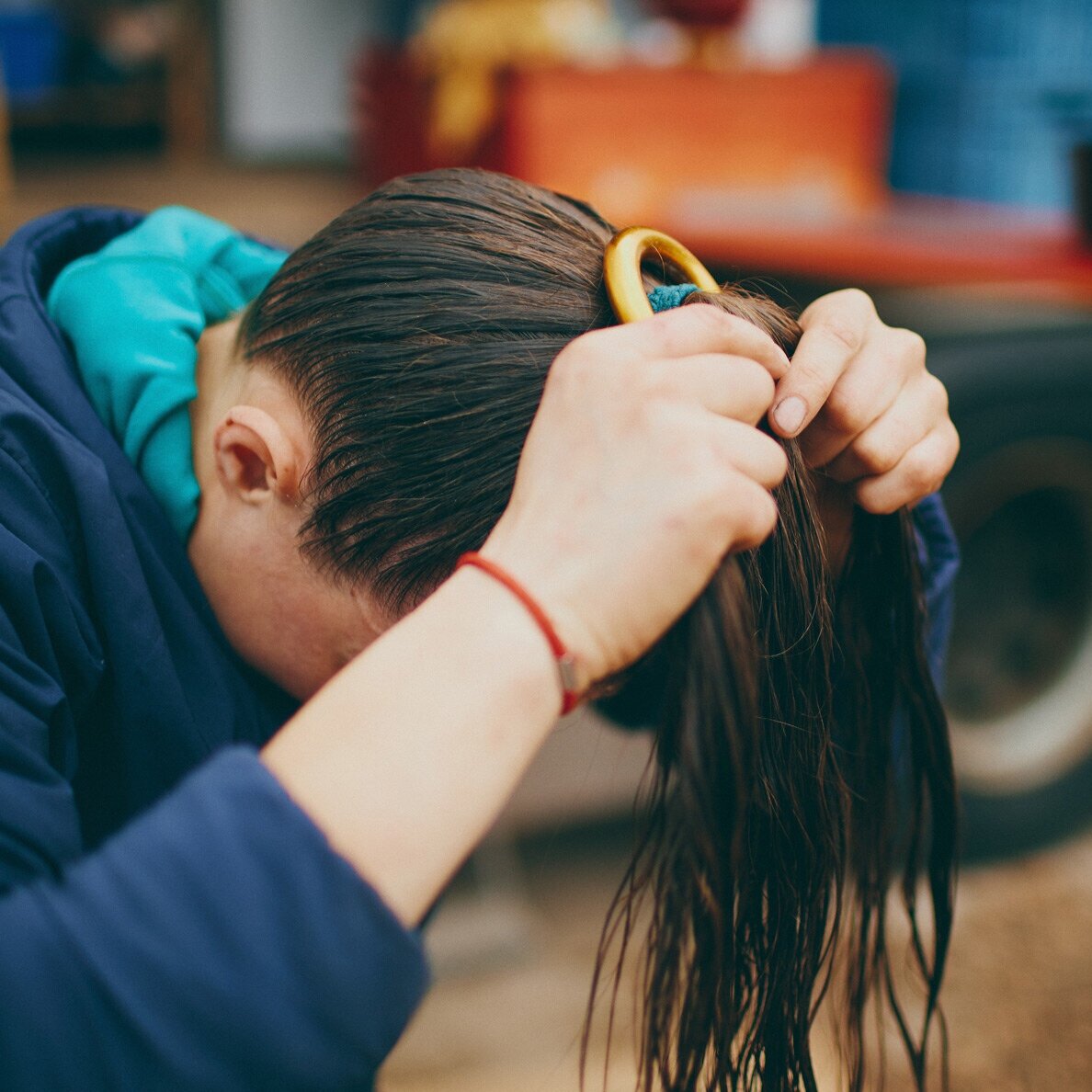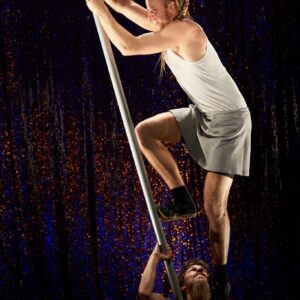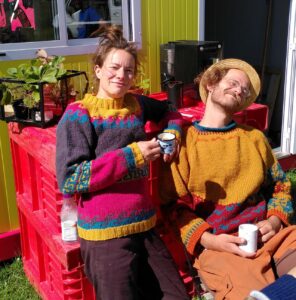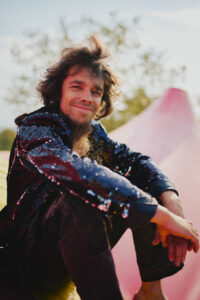

Wanting to hang from the hair
I learnt hair hanging in 2015, after having watched several of the circus artists I knew perform the skill. “Looks fun,” I thought, “I’ll give it a try! Can’t be so hard…” My first attempts were hanging from a tree branch in the yard with some kind of a 2-braided knot I invented around a basic carabiner. The first try was a miserable failure, but I kept on trying.
During the process I understood that teaching the technique of hair hanging is an opinion divider. Some people prefer to keep their secret, others are happy to share. As I myself have discussed the method, knot and gotten help from others, I wish to share my knowledge as well. And as it is with most circus skills, to know in theory how something is done is still hours of work away from actually doing it, yet along having it as a solid part of your daily performing repertoire. Everyone hanging from their hair has to do the work needed to manage, even if they had help in starting the process.
Many ways to do it
Human hair is strong, and assuming you are not bald, you have enough hairs to carry your weight. One strand is said to carry up to 100g, so a head could potentially carry several tons. This said, the focus should be in creating a knot that has capacity to carry the body weight with good margin. It is not going to be the hair that breaks, but rather the knot opening that would lead into the person falling.
I have seen several different ways of creating a hairdo that makes it possible to hang. Most people are looping their hair around a ring, and then braiding the end of the hair, so that the braid has enough friction to keep the ring from slipping out. Some braid the ring within the strands of the braid, others do a kind of a cow hitch around the ring. Some splice the rope they would be hanging from into the braid, some just do a ponytail and have someone grab the loose hairs in even manner and hang from the grip. Some people prefer the knot to be as close to their scalp as possible, others have an “elf hat” type of style. Most of the hairstyles are done into wet hair to make the hair more elastic (makes the knot easier to do and the pull more even on the scalp), but I saw some hangers just have someone grab their head of dry hair and pull them up. This to say, there is no one right way. Some hairhangers are also just attaching a part of their hair in the knot, making the hanging possible even with partially short hair. I have seen people of all heights and weights hang, you do not need to be tiny and light to do it, but strong enough.
Whatever your method will be, you should become aware of where the friction is in your hairstyle, and make sure the friction is strong enough, and the hairstyle cannot suddenly come loose. The friction of the hairstyle is what keeps you from falling down. For example in the method I demonstrate now it is very important to hook onto the correct half of the ring. If you hook into the other half, the ring will instantly pull itself out of the braid. I use this method because for me it is convenient that I can undo my hair within seconds during the performance. In the hairstyle I use you need to have hair long enough to create enough braid after the ring. What is “long enough” will depend on your hair quality and thickness.
So, does it hurt?
For me, yes. I have never had a day when I would want to stay casually hanging from my hair because I’m so comfortable there. At the best, it’s minorly uncomfortable. At the worst I cannot hang. Usually the worst happens because I have failed doing my hairstyle, thus failed to create an even pull around my scalp. The more you manage to create an even pull everywhere on your scalp and center your knot, the less the hanging is painful. If there is a small place being pulled more then others, it can be very painful. Some days you also feel more sensitive than others. The presence of audience always has a positive affect on the pain management. Because you want to show off your skill to them, you feel less pain and tend to hang a lot easier and longer. Personally, endurance training alone in the cold is the hardest mission for me, but as I want to be prepared and be fit for more than what I perform in the show, I do this training as well to avoid performing on the edge of what I’m capable of.
how I prepare my knot

- Gathering ingredients
- Brush hair with head upside down
- Dip head in bucket filled with water so all hair is wet, lift head up and comb hair with thin comb to not have any knots.
- After hair is all combed, dip head in bucket again. Lift head up keeping your head as straight down as possible.
- Grab all hair with your hand, so the pull to all hair in head is equal. Put hairband exactly on this spot without pulling single hairs more than others. This is important to do well. If some hair is already now more tight than others it will hurt a lot later on.
- Put all hair in ponytail inside the ring
- Divide hair in ponytail into two, and pull them back to the side where the ponytail is from under the ring. Your hair will form a cow hitch around the ring.
- Divide hair into 3 instead of 2
- Braid the hair and place hairband to secure.
- If you want, you can wrap a shoelace a few times around the ponytail part, just at the beginning of the braid under the ring. This is not for security, but to keep the hairstyle from doing “elf hat” too much. Also helps keep my ring the right way up.
- Hang
Notes for rehersal
-Take it easy with the hanging. increase weight you put on the hair and the amount of time you rehearse gradually, little by little every day, and take days off to let your head and muscles rest. Pain, how you feel it, how you get used to it, what is not harmful pain, and what is a sign of something being wrong cannot be told from the outside. You need to stay aware of what your body can take and progress accordingly. Generally nobody’s neck is used to hanging, so strength building up takes some time.
-For me it took me about one month of 2 times a week rehersals to do my first full weight hang of some seconds. I did this randomly on the side of other training and life I did, not as part of a well-prepared training plan. Some people manage instantly. It might be beneficial to train with a scale underneath, to see the progress of how much weight you can take, even if you cannot yet lift your feet off the floor.
-“The egg” is a phenomena known to hair hangers, that can happen and that I personally try to avoid. It is the layers of your scalp coming a bit apart from each other, resulting in a liquid bubble forming under your skin. It can be painful, but it will normally heal in some days. The sound you hear in your head when it happens is really weird, an undescribable flop.
-Spine or joints making cracking noises while you give more weight to your hair are also common. Personally I really enjoy them and feel like I get some self-made chiropractic treatment while warming up for the hang.
-Don’t be an idiot. You are responsible of making your hair hanging practice safe, so make sure the materials you use and the places or people you hang from are appropriate and support the required weights with a safety coefficient.
Bonus
Sanja Kosonen & Elice Abonce Muhonen, who made hairhanging popular within the European contemporary circus field with their show Capilotractées, display their version of the hairdo in their video:
I would be happy making this page more complete, so don’t hesitate to get in touch with me if there would be some relevant info you would like to add.



